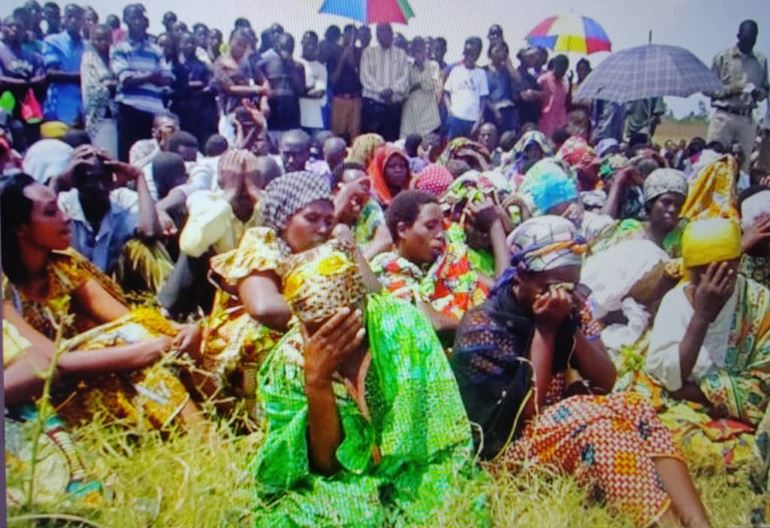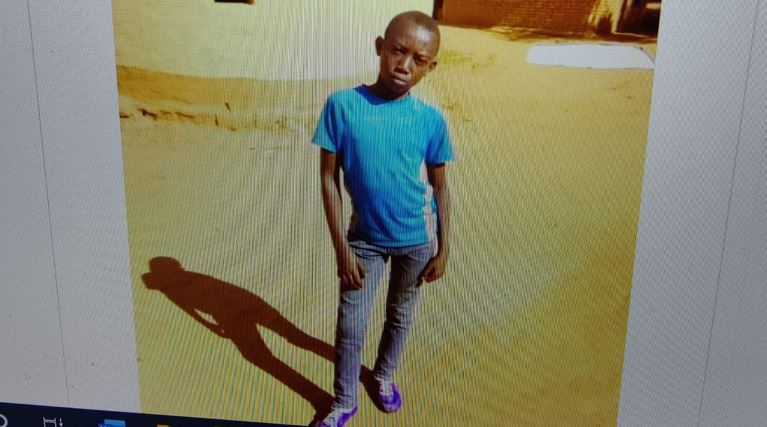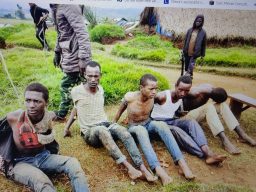
Internally displaced Kinyarwanda speaking Congolese
President Felix Tshisekedi, tells the United Nations Human Rights Council in Geneva, that the international community must protect forthcoming elections in his country. Back home, a film of a scene the type of which has become all too common in today’s Democratic Republic of Congo (DRC), is now doing the rounds on the internet. It is, to be precise, a genocidal murder. We are invited to be part of the graphic horror, and with the world having seemingly decided that any number of murdered Kinyarwanda speaking Congolese, is a price worth paying to stay in the good graces of the Congolese government, we are all complicit, in a way.
A communal murder, in broad light. There are two main protagonists, but the entire community, men, women, even children, watching as fascinated bystanders, acquiesce in the act.
A young man’s body, almost certainly dead, lies in the dust, where he has been thrown. His normally dark skin is now earthen brown, its colouration indistinguishable from his dusty infused clothes, now torn to rags, so he is partially naked. His ordeal clearly began elsewhere, and he has been dragged through the mud and dust, to get to this particular spot.
Two young men drag another body, in a similar state, but this one may or may not be dead, it is difficult to tell. They nonchalantly toss him next to the dead body on the ground, as though carelessly throwing a log. They have started a fire, and bring more kindling, covering the two bodies with it. The fire quickly catches the dry branches.
A metre or so away from the now two burning bodies, is another young man, stripped to his waste. His arms are tied behind his back, by the elbows, so his chest sticks out. A favourite way of incapacitating victims.
The torturers, for that is what they are, seem to have forgotten all about him. He is clearly still alive, now and again writhing on the ground. The movements are barely perceptible, as though involuntary, or it takes great effort to make them.
If he were to be rescued now, he would almost certainly live, perhaps psychologically scarred for all his remaining days, but he would live. But there is to be no succour for him, only the clamouring crowd, the odd person rushing forward to have a closer look at how a person dies.
According to Psychologists the mind has a way of protecting itself, turning away from anything it senses might wound it. Our own experiences bear this out. We bury unpleasant things deep within our psyches, so we can function.
Now, the mind now turns away from any attempt to imagine what the young man in the dust might be going through. Although, even if one were to have the courage to try, it would be well nigh impossible to have even the slightest inkling of his anguish, however empathetic one might feel.

Kinyarwanda speaking 14 year old boy murdered and his hand taken as a trophy

Has he resigned himself to his fate? He must know his life is about to end, all hope abandoned. Does he pray it ends quickly? Is there fear, or is he beyond that, what remains for him to endure and to die? Questions we dare not ask as we watch. And so, we protect our minds from imaging his agony, and abandon him to his fate.
In moments of extremis, the sight of other human beings brings hope. Not in this case, not for Kinyarwanda speaking Congolese, in the DRC. In this land that has consciously, with sustained intent, suffered itself to become a hell for some of its people, other human beings mean only inexplicable hate, and unimaginably horrifying death.
Whatever the state of the young man’s senses, his torture continues, as the two tormentors, now begin to also cover his body with the dry branches. He is about to be burned alive.
What shocks almost as much as the diabolical deed itself, is the extent to which all this has become accepted as natural. The young murderers go about their macabre business methodically, unemotional, as though what they are doing were perfectly normal. Nothing to see here, just torturing and murdering another Tutsi, move on, there is water to fetch, an evening meal to cook, life goes on.
The young men about to be little more than charred remains, are neither the first, nor will they be the last to suffer such a fate. Late last year, two more young Kinyarwanda speaking young men, were murdered, burnt and cannibalised. Then as now, the perpetrators filmed themselves in the act. They seem to celebrate the horror, apparently impressed by how depraved they dare to be.
What we are witnessing is genocide. Alongside it, we are witnessing not the indifference of the world community, especially the most powerful nations on earth, but a conscious decision to turn a blind eye, and divert attention away from naming the crime.
There is a heavy United Nations presence in the DRC, in the form of the grandly named, United Nations Stabilisation Mission in the Democratic Republic of Congo (MONUSCO). It has been in the country, for just over twenty years now, at the eye watering cost of over a billion dollars a year. MONUSCO replaced an earlier mission, because, according to the United Nations Security Council, a more robust mission was needed to respond to the violence in the country.

UN representative in DRC and Head of MONUSCO Bintou Keita
Not a word has been heard from MONUSCO, since not only these murders began, but since, like some poisonous cloud, the hate speech that calls for the murders, began emanating from the mouths of Congolese politicians, almost on a daily basis.
But if far from excusable, perhaps MONUSCO’s decision to avert a discreet eye from the horrors being perpetrated under its very nose, do nonetheless have some logic. The UN, which has recently extended its mandate in the DRC for a further year, and who knows, perhaps another one after that, could not have been able to do so, without currying favour with the Congolese government, which is responsible for all these crimes.
And so, the UN Special Representative in the DRC, and head of MONUSCO, Ms Bintou Keita, is in real danger of becoming little more than a shill for the crimes of the Congolese government, crimes that she is supposed to prevent.
With every atrocity, Ms Keita’s response is either a deafening silence, or a contrivance to place the blame at the foot of of the M23 rebel group, instead of the instigators and perpetrators of the crime, the government of the DRC, its military FARDC (Armed Forces of the Democratic Republic of Congo), and their allies among the armed groups, including the Rwandan FDLR (Democratic Forces for the Liberation of Rwanda).
The murder of these young men in 2023, in a way, began in 1994, long before they and those who would become their murderers were born. In another film that can be linked directly to the horror scene of these murders, a young woman, Francine Kalala, exhales hate, promising Kinyarwanda speaking Congolese, that the 1994 Rwanda genocide against the Tutsi, was as nothing, compared to what awaits the Tutsi of Congo.
Were her life to depend on it, on pain of suffering the horrific death she wishes, and is apparently ready to have visited upon others, Kalala, would not be able to explain the reason for her all consuming hate. She could not explain it, because she has grown up with it, inhaling it in the very air she breathes.
How the DRC became a genocidal society, can be traced back to 1994, when the genocidal forces in Rwanda, were defeated by then Rwanda Patriotic Army (RPA), now Rwanda Defence Force (RDF). Determined to protect their proteges to the very end, the French military protected, and escorted the defeated planners and perpetrators of the genocide into the DRC, then Zaire.
Under the protection of French forces, and the blessing of Zaire President, Mobutu Sese Seko, the genocidal establishment crossed into Zaire, having emptied their country of everything, including literally, kitchen sinks, and armed to the teeth. Once there, they set up their so called government in exile, which continued getting support from France.
Mobutu’s successors not only assimilated what is now the FDLR into Congolese society, the society absorbed the ideology of mass murder that came with the FDLR. It is that ideology that we now see in action, with the touchpaper for its intensification, lit by the hate speech from the DRC political class.

Kinyarwanda speaking Congolese rounded up by DRC forces
The genocidal murders are of course, nowhere near the scale of the genocide against the Tutsi in Rwanda. This however, is cold comfort to the relatives of the murdered, and the many who fear they may be next. For the Kinyarwanda speaking Congolese, especially the Tutsi, and Banyamulenge, the stance of the powerful nations of the world, is chillingly analogous to their decision in 1994, to abandon the victims of the Rwanda genocide to their fate, while giving support to the perpetrators.
Shockingly, not even the latest statement from the UN Special Adviser on the Prevention of Genocide, Alice Wairimu Nderitu, mentions the targeting of the Congolese Tutsi. The statement contents itself with a generalised call against persecution and murders on the basis of ethnicity.
But even with these omissions, Ms Nderitu’s statement still goes far farther than either the European or the American political leadership, and it would seem media, are prepared to event hint at, let alone state categorically, all in the name of ingratiating themselves with the DRC government.
Nothing, it seems, must be said to upset the Kinshasa government, whose main leverage against condemnation it has amply earned, is that they can, at the drop of a hat, call upon governing party youths, to unleash violence upon MONUSCO, and other foreign interests in the DRC.
It is against these interests that the lives of Congolese Tutsi are being measured, and the inescapable conclusion is that these lives, are deemed to be worth less, than the promise of controlling the famed untold riches of the DRC.


